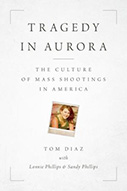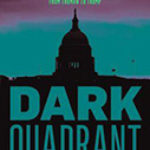Tragedy In Aurora: The Culture Of Mass Shootings In America

Authors: Tom Diaz, Lonnie Phillips, and Sandy Phillips
Publisher: Lanham, MD: Rowman & Littlefield, 2019. 286p
Reviewers: Daniel Tomascik and Brandon Dulisse | August 2021
In the past year, mass shootings in the United States have not only occurred with an alarming frequency, but are often reduced to mere blips in the headlines, supplemented with shallow condolences without tangible solutions offered. In Tragedy in Aurora: The Culture of Mass Shootings in America, Tom Diaz, together with Sandy and Lonnie Phillips, explore the historical and political context that has led to both mass shootings and gun violence becoming a staple of modern American culture, eventually concluding that an increase in gun control grassroots organizations is a necessary catalyst for change. The book constructs its argument on the timeline of Lonnie and Sandy Phillips’ daughter, Jessi Ghawi — that is, between her two experiences with mass shootings: a near miss in Canada, and a tragic death in Colorado. In telling her story, the authors not only place the focus of these shootings on the impact on the victim and their family, but also create a complex and troubling picture of modern American gun violence.
The book begins with a lengthy discussion of political psychology — specifically how changing attitudes led citizens to leave tight-knit social groups bound together by geographic proximity, and to instead join increasingly polarized groups bound primarily by ideology. Fallout from the Vietnam War and the Civil Rights Movement in the 1960s, in addition to a new era of economic insecurity and distrust of government, drove typically moderate citizens to seek groups that looked, acted, and thought in ways that they did. According to the authors, one result was that conservative, pro-gun organizations – the NRA among them – were able to not only galvanize everyday gun owners, but to also pursue legal strategies in securing case law and policies that supported their interests. In contrast, gun-control organizations presented “elitist” policies that were lobbied directly to legislators, with no role for the average pro-control citizen-activist to play, and no grassroots organizations to compel support among ordinary citizens. The modern result is a gun lobby and industry that is seemingly immune from impactful criticism, such that even powerful gun-control leaders view guns as a “third rail” of politics, meaning that even in the wake of mass shootings, lobbyists on both sides advocate for a simple dichotomy of solutions, — thus further polarizing those seeking a solution to gun violence and mass shootings.
After this thought-provoking introduction, the authors begin Chapters One and Two by exploring a comparative difference in gun policy and culture between the United States and Canada. This comparison is made through the narratives of two individuals at the center of this issue: Jessi, who narrowly misses a public shooting at the Eaton Centre in Toronto, and the shooter himself, a Canadian, who targeted a specific individual but in the process of his crime also shot five bystanders. While gun violence is on the rise in Canada, it pales in comparison to the extent that it exists in the United States. Despite coming from similar colonial backgrounds, both countries have branched off in terms of their respective gun culture. According to the authors, Americans evolved to see guns as a tool of self-preservation and individualism, while in Canada guns were seen primarily for sporting uses with the government serving as their protector. This explains a deviation in not only gun policy, but in the public attitudes towards weapons in two countries with similar histories.
Chapter Three shifts from a comparative discussion and instead introduces a case study on Charles Whitman, aka the “Texas Tower” shooter of 1966. Here the authors present a brief personal history of Whitman in an effort to demonstrate the typology that many mass shooters seem to have in common, while also documenting the events that lead up to the August 1, 1966 shooting at the University of Texas at Austin. In their presentation of this profile, the authors point out similarities between this early modern mass shooting and those that followed. Perhaps most importantly, the authors address two points central to their overarching argument: 1) that the Texas Tower shooting was not a “snap event,” but was instead planned several months in advance; and 2) Whitman was especially able to commit this crime because of his gun background and training in the US Marine Corps. Without it, the inherent limitations of the hunting rifle he used would have significantly limited the damage and loss of life that day. This strongly suggests that the sheer fire power available by the use of “assault rifles” is a factor in the increased number of mass shootings.
Chapter Four deals with the current controversy on just what constitutes an “assault rifle,” as well as the legality and definition of other high-powered rifles much vilified by gun-control advocates and glorified by gun enthusiasts. The authors take particular issue with the widely-known AR-15, which gun enthusiasts delineate as a “modern sporting rifle,” and not similar to military rifles. Pro-gun control advocates contest the view that the AR-15 is merely a civilian variant of the military M16, but say rather that they are functionally similar. The semantic issue of what constitutes an “assault rifle,” the authors say, is largely a distraction — regardless of the name, the ability of each weapon to enable mass shootings is equivalent. The authors also present the argument that many unscientific “black box” statistics allow the gun lobby to routinely suggest that mass shootings are not unique in the United States, but occur elsewhere as well. To others on the pro-gun side, mass shootings are unpreventable, and are simply an unfortunate consequence of a nation’s established right to private ownership of firearms.
The authors then focus on the current controversy surrounding background checks by again unpacking another case study, this time using the Aurora, Colorado movie theater shooter. James Holmes began chronicling in a journal material that appeared to reflect a form of mental illness and specifically psychosis. This eventually culminated in a plan to kill as many people as possible, in a process similar to Charles Whitman’s. In preparation, Holmes stockpiled a number of guns purchased legally from local gun shops in the area, as well as making several unregulated online purchases. Though the authors recognize the existence of a current background check system – the National Instant Criminal Background Check System (NICS) – they describe its ineffectiveness in possibly stopping mass shootings. Despite being the latest and perhaps most significant effort in American gun control policy, NICS works by retroactively examining the past histories of prospective buyers, seemingly “checking boxes” for previous misconduct. Compared to other nations (Canada is used as an example), the NICS is much less strict and more limited in encroaching into the personal backgrounds of citizens looking to purchase a firearm. Additionally, the NICS relies on self-reported data from individual states, which can at times be underreported, late, or not reported at all, allowing for the possibility of prohibited buyers in one state to buy a gun in another state. It should also be mentioned that 40% of gun sales are conducted personally, online, or at gun fairs, none of which require registration. In sum, James Holmes never raised a red flag on any background checks despite the documentation of his mental health issues.
The authors describe the push to change police response procedures to active shooter events. Speaking with then-chief of the Aurora Police, Daniel Oates, they note how SWAT teams – trained to handle these kinds of events – can take quite a while to set up, and that the questionable police practice of waiting for them was criticized after both the San Ysidro mass shooting in 1984 and the 1999 Columbine shooting. The authors recognize that police procedures have been changing to respond more quickly and effectively to shooting events – Aurora PD being among departments making changes. – Despite this, it should be recognized that the skills required to respond to a mass shooting event are not the same as what is required for routine patrol or general policing, and police officers are putting their lives in serious danger when they respond to such events. Diaz, et al. make the point that updated police policy – a reactive approach versus a proactive approach – in this era of mass shootings may/will never be sufficient. As a prime example, the Aurora PD handled the shooting incident perfectly given their training and resources, but in the end twelve people still lost their lives.
The last two chapters are devoted to the authors’ proposed solutions for changing the current culture through organizational support and various approaches — specifically addressing why change has not worked in the past, and what might be successful given the current political climate for the future. Gun control policy groups and thinktanks have traditionally used “inside-the-Beltway” techniques of directly lobbying congressmen for legislation, sometimes using survivors for “sound bites,” but then ultimately dismissing them for a perceived lack of emotional restraint and judgment. Meanwhile, for several decades the pro-gun movement has been able to galvanize a group of lawyers who focus on case law. Additionally, the anti-control people have fostered grassroots activism, wherein average, everyday gun owners actively attend meetings and town halls, and go anywhere else the Second Amendment has been seemingly threatened. Without strong, organized leadership on the pro-control side of the debate, similar grassroots movements that may mirror anti-control movements in effectiveness have failed to materialize. The authors note, however, that social movements very often start from positions of weakness, and continue to work despite rises and falls in interest of such events, in this case immediately after shootings. Finally, they point to key policy changes to focus on – comprehensive background checks and threat management, a restriction of access to assault weapons and high-capacity magazines, and the renewal of old prohibited classes – and make a note that current “elitist” pro-control tactics are not working. To that end, the authors reiterate that meaningful gun control legislation must come from a cultural, incremental change starting from well-organized grassroots organizations.
Overall, the authors present an enlightening history of the debate over firearms and cover the biggest general topics of the current debate in ways that were informative, well-referenced, and interesting. Their discussion of the current state of the gun culture is well-supported. Histories of the assault rifle as well as both control and anti-control movements can help anyone currently engaged in this discourse to better articulate talking points and base their knowledge on a better foundation. Their discussion of the changing political psychologies is particularly fascinating, and we would encourage anyone interested further in those topics to engage in some of the material Diaz and the Phillips have cited. Additionally, the use of case studies (with a particular nod to the identification of the Texas Tower shooter as a primary example) are excellent methods by which to see the event of a mass shooting from start to finish, and is a great point of comparison with the more recent instance of James Holmes and the Aurora shooting.
Their solutions to mass shootings are well-supported if somewhat bleak — the idea of an incremental change in the gun culture to the point where policy will be likelier to pass certainly mirrors the perspective of the conservative side, but the possibility of it happening in the United States seemingly remains a hard pill to swallow. What would have added some empirical weight to their argument would have been a look at more current efforts that include the solution they prescribe. The authors do touch on real world versions of their solution already in place — not merely the Giffords Law Center and Survivors Empowered that the Phillips are affiliated with, but indeed the “Parkland kids”. That name refers to a movement started by students of the Marjory Stoneman Douglas High School who experienced a mass shooting in 2018. Rather than remain quiet, these students took to speaking to news outlets in outrage, writing books about their experience, and organizing rallies and public support. Far from “inside the Beltway,” these students were and are appealing directly to their fellow citizens about the importance of gun control. This seems to be an organization that is exactly what the authors are describing as a solution, and thus it would have been useful to note how their movement has been getting along and how their strategy has worked, even in its early stages and absent a formal evaluation.
In sum, Diaz and the Phillips present an engaging piece of research on a contentious and all-too-real piece of American culture, and provide an entree into this discourse that will be valuable to anyone wanting more context, or anyone wanting to find a way “in” to activism on the gun control side of things – the very thing we believe the authors may be hoping for.


